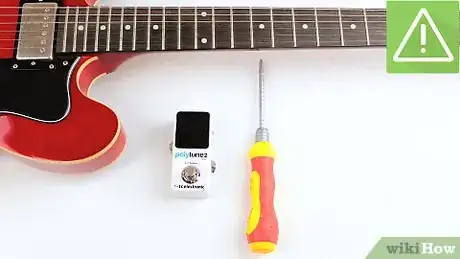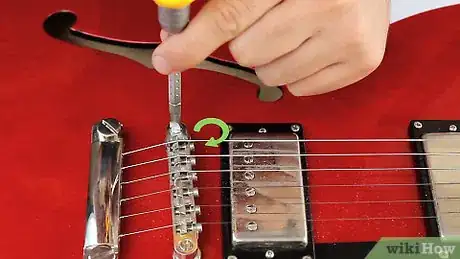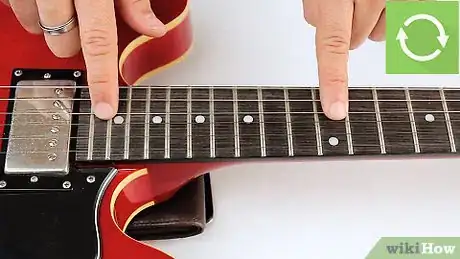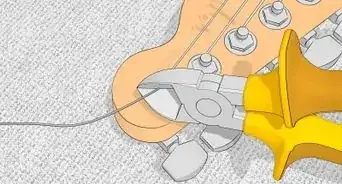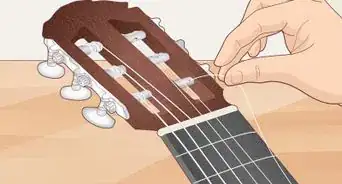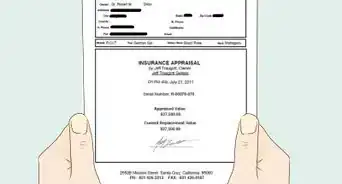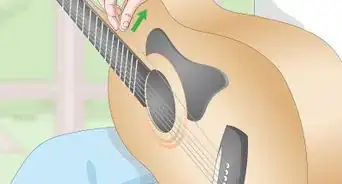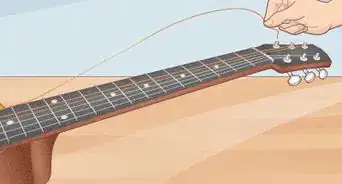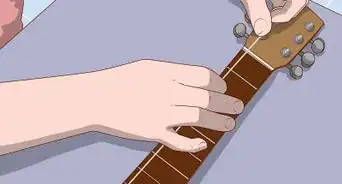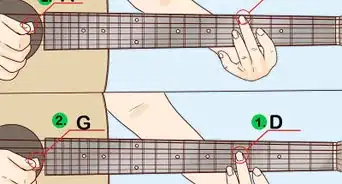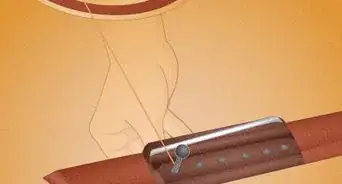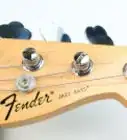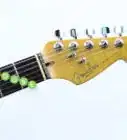wikiHow is a “wiki,” similar to Wikipedia, which means that many of our articles are co-written by multiple authors. To create this article, 52 people, some anonymous, worked to edit and improve it over time.
The wikiHow Video Team also followed the article's instructions and verified that they work.
This article has been viewed 880,738 times.
Learn more...
Sometimes your guitar will be out of tune even after you tune it, which means your intonation is out. You can tell when your intonation is out if an open string harmonic at the 12th fret (lightly touch string at the 12th fret and pluck it) and the fretted note one octave higher (hold the string down at the 12th fret and pluck it) are not the same. Guitar intonation tuning is making the notes of each fret of a string equal to the chromatic reference pitches, or the natural musical scale temperaments by adjusting string lengths at the saddles. The chromatic musical scale and natural musical scale are similar, so tuning the natural musical scale of the brass instruments is preferred. This makes the twelfth fret note of a string theoretically be about one octave higher than its corresponding open string note pitch, and the seventh fret note octave pitch similar as the corresponding seventh fret harmonic pitch.
This process is identical for both bass and guitar.
Steps
-
1Read through the Tips and Warnings at the bottom of this page. There are several facts that you need to know before you perform this process.
-
Video Player is loading.
This is a modal window.
The media could not be loaded, either because the server or network failed or because the format is not supported.2Tune your instrument to the tuning you're planning to play in. Tune all of the strings directly to the tuner. No 5th fret or harmonic tuning here.[1]- For electric or acoustic-electric instruments: Use a programmable electric tuner with stroboscope display that you can plug directly into. A mechanical stroboscope can be the most accurate display in 2010. Use the chromatic equation below to get the pitch frequencies fn for this programmable tuner.
- For acoustic instruments: Use an extremely quiet (and dead) room with a mic tuner. Remember, set up your instrument for the tuning you're going to use. If your band plays in drop D, Ab standard, G modal, or any other tuning you should tune your instrument to the tuning you are going to use. Standard E drop to D is better than standard tuning because of lower string tensions.
- Bassists: Throughout this process you should be using a pick, even if you do not normally play with one. The way we pluck the string with our fingers works very well when we're playing, but it just is not accurate (or consistent) enough for this process.
- For all instruments: Tune the entire instrument several times. As the tension on each string changes it may alter the way your neck is sitting and may detune your other strings. Stick with this step until every string is open tuned as close as possible to perfect. When you're tuned, move on to the next step.
Advertisement -
3Adjust your action. If you have any desire to raise or lower your string action (the distance between your strings and the fretboard) you should do it now. This means if the string is buzzing raise it so that it does not! When the string is vibrating or buzzing on the next higher pitch fret, the note pitch can quickly and temporarily switch making intonation tuning very difficult. The two pitches may briefly and temporarily blend making sometimes the note pitch a little sharp. The buzzing sometimes produce some harmonic pitches that can reduce the purity of the pitches of the higher pitch frets; the tenth fret note pitches can sound a little higher. The smaller the magnitude and duration of the buzzing on adjacent frets the smaller the offsets d has to be. If you alter your action after you complete the intonation setting process, you may undo all of the work you are about to do. If you do alter your action on any string, repeat step 2.
- The better quality guitars can have their strings closer to the frets with less buzzing. The closer the string(s) to the frets, the less the string stretching and tension increase when pressed, the smaller the offsets d have to be, the significantly (exponentially) better the intonation tuning due to less string stretching, but string buzzing may perhaps sometimes reduce intonation tuning.
- Place the strings as close as possible to the frets; if some buzzing on next higher fret can be heard increase the distance slightly. There may be some string buzzing permitted at frets higher than twelfth fret. The more expensive guitars can have their strings closer to the fretboard and so have better intonation tuning. The intonation tuning error due to string stretching is (T2+(T (2 yi/s))2)1/2-T, where T is the open string tension of the ith string, and yi is the distance between the side of the ith string and the twelfth fret peak. From these equations can tell that intonation tuning improves as string tension T reduces and distance yi between string and twelfth fret reduces with offsets d minimized.
- Need to keep yi small as possible for first string to achieve intonation tuning. If the distances yi between strings and frets are too large, intonation tuning will be impossible.
-
Video Player is loading.
This is a modal window.
The media could not be loaded, either because the server or network failed or because the format is not supported.4Figure out how far off you are. Fret the string at the 12h fret and pick it. The pick should be moderate, not too hard, not too soft. When fretting, pay special attention to fret only as hard as is necessary to prevent the string from buzzing.[2]- Even with a standard un-scalloped fretboard it is possible (especially on guitar) to bend the string sharp several cents by fretting too hard. In normal playing it isn't generally an issue, but for this process you need maximum accuracy. When you play that string at the 12th fret, observe your tuner. If you are sharp (too high) or flat (too low) your intonations are off and an adjustment will need to be made.
-
Video Player is loading.
This is a modal window.
The media could not be loaded, either because the server or network failed or because the format is not supported.5Fix it. Adjust the saddles. Depending on the type of saddles you have determines if you turn the adjustment screws for the each saddle clockwise or counterclockwise.[3]- If the note on the 12th fret is sharp, that would mean that the saddle for that string needs to be moved back away from the headstock.
- If the note on the 12th fret is flat, that would mean that the saddle for that string needs to be moved forward toward the headstock.
- Compare the twelfth fret note to the corresponding twelfth fret harmonic pitch with electronic tuner for meter. This is decent intonation tuning for notes between nut and twelfth fret range.
-
Video Player is loading.
This is a modal window.
The media could not be loaded, either because the server or network failed or because the format is not supported.6Check it. After you make a saddle adjustment, you will need to repeat step 2. Make sure the entire instrument is still perfectly in tune.[4]- Once you have completed step 2 again, re-fret the 12th fret on the string you just made the adjustment on and check it on the tuner. You should see that it is not in the same place anymore. If the 12th fret note isn't perfectly in tune while the open note is perfectly in tune, you need to repeat step 4 until it is.
- Tune the open string note and check the fifth fret note with a mechanical pitch pipe. If the fifth fret note is still a little sharp (high), move the bridge (bridge saddle) back a third of a millimeter. Play some songs on one string and adjust the string length at the bridge accordingly if the intonation does not work well. If it is perfect you are done with that string.
- Tune the first fret notes by adjusting string tensions; and compare the second to twelfth fret notes of a string with the chromatic electronic tuner pitches. Compare notes of a string with an organ/chromatic pitch pipe link below, and if most of the higher pitches are too high relative to pitch pipe pitches and first fret note, lengthen string by about 0.2 millimetre at bridge, or if too flat (low) move bridge forward (toward fretboard).
- Repeat this until the notes from nut to twelfth fret of a string closely matches the references pitches. Better intonation tuning of a string occurs when the twelfth fret, sixteenth, and nineteenth fret notes pitches equal their corresponding harmonic pitches.
- Fine tune by playing "Mama's Pearl" (J5) guitar lead on one string.
-
7Do the rest. Repeat the process as outlined here for each string on the instrument tuning frequently.[5]
-
8Enjoy. Once you have the instrument completely set up, play a nice fat major barre chord. Listen to all of those overtones you've been missing! Now, kick on your distortion and notice how your guitar is suddenly 300 times more powerful.
Community Q&A
-
QuestionWhat can I do if my 12th fret note is still sharp when the saddle has been moved back (away from the fret board) as far as possible?
 Community AnswerTake the saddle off. Remove the spring. Put the saddle back in the bridge without the spring. This should give you a bit more room to bring the saddle back and make the string less sharp. If you need more room, take the saddle out again and grind the back side of the saddle, making the saddle shorter. Leave enough threads in the saddle for the screw.
Community AnswerTake the saddle off. Remove the spring. Put the saddle back in the bridge without the spring. This should give you a bit more room to bring the saddle back and make the string less sharp. If you need more room, take the saddle out again and grind the back side of the saddle, making the saddle shorter. Leave enough threads in the saddle for the screw. -
QuestionWhy are strings offset at the bridge? Wouldn't this mean that the 12th fret is NOT the middle of every string?
 Community AnswerHeavier gauge strings need to be slightly longer to match the intonation of the lighter gauge plain steel strings. The lower tension and larger mass of the wound strings travel slightly more when fretted. This is why acoustic guitars are offset at the bridge like this.
Community AnswerHeavier gauge strings need to be slightly longer to match the intonation of the lighter gauge plain steel strings. The lower tension and larger mass of the wound strings travel slightly more when fretted. This is why acoustic guitars are offset at the bridge like this. -
QuestionI have a brand new standard Tele, and a string is in tune open but sharp at the twelfth, then in tune at the twelfth and flat open. What do I do?
 Community AnswerAdjust the saddle so that the string length is longer. If the twelfth fret is sharp, the string is short.
Community AnswerAdjust the saddle so that the string length is longer. If the twelfth fret is sharp, the string is short.
Warnings
- Sometimes thin strings can snap with little effort when stretched too tight so watch out! You may want to avoid higher pitch tuning of open strings other than standard tuning.⧼thumbs_response⧽
- Setup your instrument to a specific tuning. It isn't going to help you to set up your guitar in E standard (E-A (A440)-D-G-B-E) if you play in drop C (C-G-C-F-A-D) all the time!⧼thumbs_response⧽
Things You'll Need
- New strings; use standard gauge hand wound strings (e.g., soft elastic pure nickel (expensive DR), round core, compression wound) or thinner.
- A four to six songs and their corresponding accompaniment notes for voice as pitch pipe for main source of reference pitches and lead. Use tunes that have a wide note range; preferably five or more notes.
- A high quality mechanical chromatic pitch pipe set for guitar with A440 standard for comparison of fret pitches. W. Kratt "The Master Key" C to C chromatic pitch pipe set has purer pitch tones in 2010.
- An A440 tuning fork tuned to 440.0 hertz pitch for main standard reference pitch.
- Programmable tuner with a mechanical stroboscope display and electronic pitch pipe with 0.01 cent accuracy with purer reference pitch tones (a must if you can afford it) for tuning experimentation and study. Its mechanical stroboscope may be purer than electronically generated reference pitches.
- Small Allen wrench (instrument dependent, may come with guitar)
- Phillips and flat-head screwdrivers (instrument dependent)
References
- ↑ https://www.cyberfret.com/guitar-maintenance/guitar-intonation-setup/
- ↑ https://www.guitarlessons.com/guitar-lessons/alternate-tunings-guitar-maintenance-and-jams/setting-your-intonation-on-guitar
- ↑ https://www.guitarlessons.com/guitar-lessons/alternate-tunings-guitar-maintenance-and-jams/setting-your-intonation-on-guitar
- ↑ https://www.guitarrepairbench.com/electric-guitar-repairs/adjust-intonation-electric-guitar/
- ↑ https://www.guitarrepairbench.com/electric-guitar-repairs/adjust-intonation-electric-guitar/
